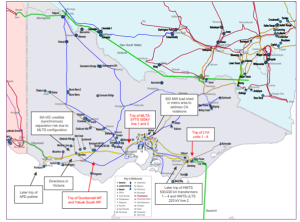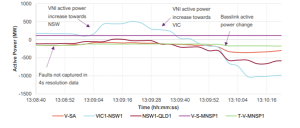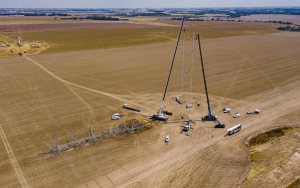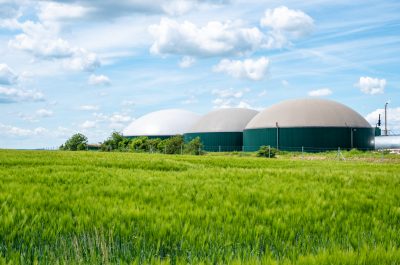Towers down but the transmission grid powers on
Energy Insider Cover Picture: Cressy incident, January 2020 (Source: AusNet)
An extreme weather event has brought an increased focus to how our changing climate can increase the risk to the network and the delivery of power to where it’s needed.
This event saw around half a million customers experience outages, and begs the question: is our critical grid infrastructure built to withstand increasingly intense storms, and where to from here?
What happened?
A major storm on 13 February knocked down six transmission towers near Anakie, Victoria on the 500KV transmission line between Moorabool Terminal Station and Sydenham Terminal Station.
- 1.09pm: six 500KV towers came down, tripping the transmission line, with a subsequent disconnection of all four generation units at Loy Yang A power station. Between Loy Yang and two wind farms offline, Victoria lost 2,900MW of generation and 1,000MW of load came off following the disturbance.
- 3.43pm: a further storm cell hit between the Hazelwood Terminal Station and the Jeeralang Terminal Station which tripped four transformers.
- Separate to these events on the transmission system, the storm also caused widespread outages across the Victorian distribution networks with a peak of 530,000 customers off supply.
- 2.20pm: the Australian Energy Market Operator (AEMO) directed AusNet, the transmission network service provider, to commence load shedding of 300MW to keep the power system secure. AEMO subsequently instructed AusNet to restore the load at 2.50 and 3.10 pm.
To give some indication of the magnitude of the storm event and effect on networks, winds recorded at 1.19pm at Avalon Airport were 122km/hr. The Fawkner wind beacon in the Port Phillip Bay also recorded 115km/hr at 2.19pm.
Whilst AEMO provided a preliminary incident report from 1.09-3.15 pm, more detailed analysis will be undertaken of the two transmission events with the help of AGL (Loy Yang), Tilt Renewables (Dundonnell Wind Farm), Pacific Blue (Yaloak Wind Farm), AusNet and other participants. This review will gather more data, consider the protection schemes and recommendations to improve resilience of the power system. As can be seen by the incident overview in Fig 1, a number of events across the day will need detailed consideration.
The Energy Safety Victoria (ESV) will also undertake a review of the incident, as is normal practice.
Fig 1 – Incident Overview[1]

Gas generation and interconnectors help to maintain the power grid in Victoria
Following the trip of load and generation, the flow on the Victorian-New South Wales (VNI) interconnector increased towards NSW and then changed direction. Bass Link flows also changed, reflecting the frequency dip at George Town. The interconnectors from Tasmania and from NSW flowed power into Victoria as can be seen in Fig 2.
AEMO also sought to override demand in the gas market to enable 55TJ of additional gas for gas fired generation to ensure reliability. AEMO also declared a lack of reserve and contracted via the Reliability and emergency reserve trader provisions, however AEMO did not need to activate the reserves.
Fig 2 – Interconnector flow on 13 February 2024

A sense of deja vu with the Cressy incident?
This seems like deja vu from a similar incident on 31 Jan 2020 where six transmission towers collapsed near Cressy with wind speeds in excess of 125km/hr.
In the 2020 Cressy event, the ESV concluded[2]:
- The cause of the incident was severe weather, a severe convective downburst;
- The structural integrity of the collapsed towers had no defects or issues that led to the collapse;
- The existing towers had been inspected and maintained in accordance with the AusNet’s Electrical Safety Management Scheme, a standard that ESV had accepted as meeting the requirements of the regulations;
- The design requirements for the replacement towers were being designed to a wind speed that meets the latest version of the Australian Standard AS7000 ‘Overhead Line Design’, the design requires consideration of convective downdraft wind gusts;
- The original towers were designed to older standards by the SECV which did not consider convective downdraft wind gusts;
- That all actions taken by AusNet subsequent to the event were appropriate.
While standards will change to reflect the most recent learnings and forecasts, any actions taken to improve the resilience of the power system involve a balance of cost to customers and benefits of reducing risk.
ESV, with the help of AusNet, will investigate the transmission towers collapse on 13 February 2024 in line with normal practice. The transmission towers were last inspected in July 2023, found to be in good condition and had no overdue maintenance. It may well be that the ESV has similar findings again.
The non-deja vu part of this extended event is that the storm impacted a significant number of customers across a number of distribution networks, leading to a peak around 530,000 customers off supply. The extent of tree falls downing distribution lines can lead to more extended outages. Where this is the case, clearing access and making safe any fallen powerlines is the first priority. This allows crews to come in and erect new poles and restore supply to consumers.
AEMO reported the customers off supply over the first 24 hours, and distributors undertook a massive effort overnight and the following day to get customers back on supply and have continued to work to bring consumers back on supply since 14 February.[3] While the damage was extensive, around 90% of customers were reconnected in the first 48 hours.[4]
| 13 Feb 8pm | 14 Feb 7am | 14 Feb 8pm | |
| AusNet | 262,601 | 236,901 | 112,272 |
| CitiPower | 12,854 | 12,400 | 50 |
| Jemena | 189 | 4 | 8 |
| Powercor Australia | 63,271 | 11,715 | 3,229 |
| United Energy | 134,579 | 24,572 | 12,184 |
| Total | 473,494 | 285,592 | 127,743 |
These numbers hide the real story, which is of tireless efforts from networks and their staff to restore power to customers. The process is a difficult one, with initial actions to clear downed trees and broken power infrastructure and create a safe environment, then rebuilding the power system, and finally reconnecting customers.
Severe weather events are a reality of life – indeed a certainty. The grid is built and operated to withstand and recover quickly from severe weather events. There are clear goalposts that measure the value that customers place on keeping the lights on and networks make sure their investments and operations are in line with meeting customer needs. While measures could be taken to reduce the risk of power outages, such measures should only be taken where they are valued by customers. There will be measures that cost too much for the marginal additional reliability they provide for customers.
The next steps
The Victorian distributors and transmission business will undertake a combined industry effort to get consumers back on supply and the transmission line energised again.
Whilst it is early days, AEMO anticipates that temporarily erected transmission towers will enable a return to service of the line between Moorabool Terminal Station and Sydenham Terminal Station on 22 February for the first line and 27 February for the second line, although this may be subject to weather conditions. Whilst some stock of temporary towers is held across the transmission business, the work to place the temporary towers, remove the collapsed towers and restore the permanent transmission towers is a significant job.
Fig 3 is from the Cressy event in 2020 indicating the type of construction of the temporary towers over the next few weeks.
Fig 3 – Construction of Temporary Transmission Towers, Cressy event (Source – AusNet)

As noted above there are multiple reviews afoot to consider the events and learnings. It is important to gather and analyse the data and challenge the status quo. Any recommendations must be measured, carefully balance risk and cost and be flexible enough to recognise when change is necessary.
[1] https://aemo.com.au/-/media/files/electricity/nem/market_notices_and_events/power_system_incident_reports/2024/preliminary-report—loss-of-moorabool—sydenham-500-kv-lines-on-13-feb-2024.pdf?la=en
[2] https://www.esv.vic.gov.au/sites/default/files/2022-12/Cressy_500kV_Tower_Incident_31Jan2020_report.pdf
[3] https://aemo.com.au/newsroom/media-release/power-system-event-in-victoria
[4] https://www.premier.vic.gov.au/sites/default/files/2024-02/240220-Independent-Review-To-Examine-February-2024-Storms.pdf?utm_source=miragenews&utm_medium=miragenews&utm_campaign=news

